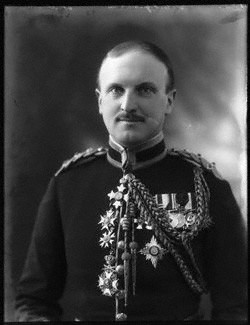Reginald May facts for kids
Quick facts for kids
Sir Reginald May
|
|
|---|---|

Gen. Sir Reginald May
|
|
| Born | 10 August 1879 |
| Died | 26 October 1958 (aged 79) |
| Allegiance | |
| Service/ |
|
| Years of service | 1898–1939 |
| Rank | General |
| Service number | 26289 |
| Unit | Royal Fusiliers |
| Commands held | 49th (West Riding) Division Royal Military College, Sandhurst |
| Battles/wars | Second Boer War First World War |
| Awards | Knight Commander of the Order of the Bath Knight Commander of the Order of the British Empire Companion of the Order of St Michael and St George Distinguished Service Order |
Sir Reginald Seaburne May (born August 10, 1879 – died October 26, 1958) was an important British Army officer. He reached the high rank of General. One of his most important jobs was serving as the Quartermaster-General to the Forces. This role meant he was in charge of supplying the army with everything it needed.
Contents
Sir Reginald May's Army Journey
Reginald May went to a school called Haileybury. He joined the Royal Fusiliers as a second lieutenant in 1898. This was his first step as an officer in the army. He quickly moved up the ranks, becoming a lieutenant in 1899.
Fighting in the Second Boer War
May served with his army unit in the Second Boer War in South Africa. This war happened from 1899 to 1902. He took part in several important battles. These included the Battle of Colenso in December 1899. He also helped in the Relief of Ladysmith in February 1900. This was when British forces rescued a town that was surrounded by enemy soldiers. After these battles, he served in the Western Transvaal region. He stayed in South Africa until the war ended. His bravery and service during the war were noticed. He was promoted to captain in 1903. Soon after, he also earned the special rank of major.
Service in the First World War and Beyond
Sir Reginald May also served in the First World War. This huge global conflict lasted from 1914 to 1918. After the war, he took on several key roles in the army. He became the Director of Movements. This meant he helped plan how soldiers and supplies moved around. Later, he was the Director of Recruiting and Organisation. In this job, he helped bring new soldiers into the army. He also helped organize how the army worked.
In 1927, he became a Brigadier. This role put him in charge of administration for the Northern Command. Then, in 1930, he became the General Officer Commanding (GOC) of the 49th (West Riding) Division. This meant he was the top commander for that large group of soldiers.
Leading Sandhurst and Quartermaster-General
A very important role for May was becoming the Commandant of the Royal Military College Sandhurst in 1931. Sandhurst is a famous place where army officers are trained. Being the Commandant meant he was in charge of the entire college. In 1935, he was appointed Quartermaster-General to the Forces. This was a very high-ranking position. He was responsible for all the supplies, equipment, and logistics for the entire British Army. He retired from the army in 1939.
After retiring, Sir Reginald May continued to serve. He was the Chairman of the Toc H Christian movement for ten years. He also held the honorary title of colonel of the Royal Fusiliers.
His Family Life
In 1906, Reginald May married Marguerite Geraldine Ramsay Drake. They had three sons together. Later, in 1932, he married Jane Monteith.

